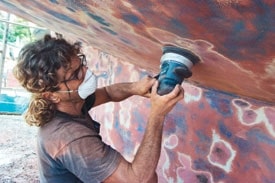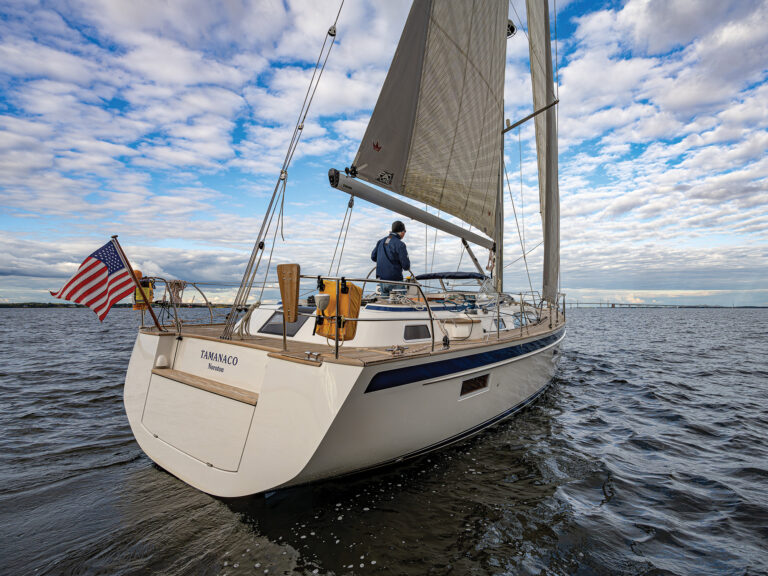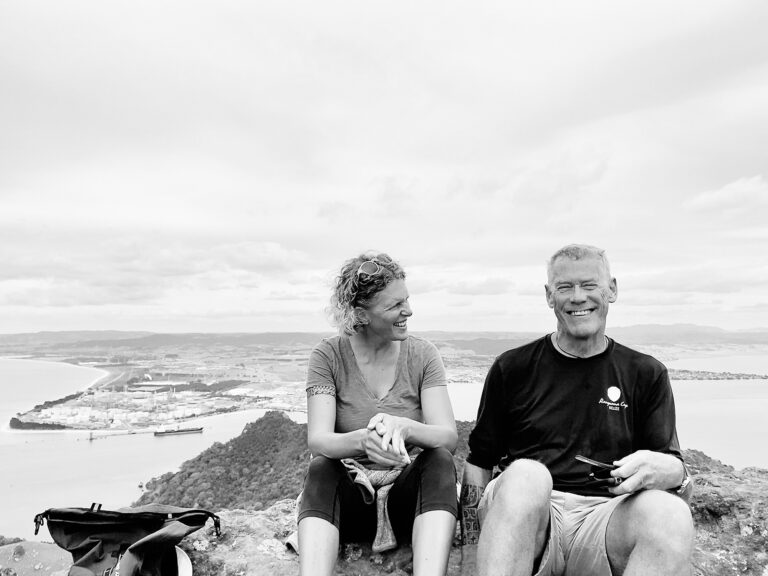
novpassnotes
“De-le! De-le!”-Go on! Go on!-the young guy shouted, giving directions to the driver who was maneuvering the Travelift around the shipyard with Summerwind swaying in its slings. At the same time, two other workers carried four metal stands and set them in a vacant spot. “Down, down, down!” he kept calling until our 32-foot steel sloop finally rested upright on the ground. As I explored the neighboring boats, I saw many that I recognized. We’d shared anchorages with them, or heard them on the radio while cruising the past season in the San Blas islands. It was clear that most of the boats in the yard were empty; quite usual for this time of year, as many cruisers take advantage of the rainy season and the safety of the fenced and guarded boatyard to travel back to their home countries. We, too, went for a short visit back to Israel while Summerwind stayed in Cartagena, Colombia, at the Manzanillo Marina Club.
A huge project awaited us upon our return. Rusted areas on our steel hull had to be cut out and new plates welded in, entailing a virtual dismantling and reconstruction of Summerwind. My husband, Yoav, does all the work himself, with me for an assistant; so we were looking at a long haul. In the many months of work, the dusty boatyard became a home, and we had time to meet and make friends with our neighbors on the hard, and to hear the varied, touching stories of their lives before they arrived in Cartagena.
We met Blanca and Leo Eijsermans first, when they’d returned from a short vacation to start working on Promesa-their 38-foot steel sloop. “How long do you think you’ll be on the hard?” I ask Leo, once he’d read off the three-page list of jobs- besides the bottom painting- that he plans to accomplish while out of the water. “A month to six weeks,” he answers. What he forgets to take into account (as did we) was that on a boat, any small job can lead to three more. Also, for those hiring workers in Colombia, “mañana” doesn’t necessarily mean tomorrow. “This culture is foreign, even for me sometimes,” says Blanca, who was born and brought up in Colombia. “The coasteños (coast people) are so laid-back.”
We worked side-by-side with Blanca and Leo, and he and Yoav discussed ideas, borrowed tools from each other, shared knowledge, and supported each other in frustrating moments. Blanca told me how, at 25, on the second night of a visit to Canada, she’d met Leo. Three months later they got married, and 30 years later, here they were in Cartagena. For many years, the Eijsermans raced their 27-foot C&C on the Great Lakes. “We sailed almost every day of the week,” Leo tells me. “We got really hooked on it.” In May 2002, one month before Leo retired as a mechanical engineer, they bought an offshore, Bruce Roberts-designed sloop, sold their house in Toronto, and by September of that year, they’d started cruising permanently.
From Toronto, they sailed down the East Coast, through the Intracoastal Waterway, across to the Bahamas, and island-hopped down the Eastern Caribbean to Trinidad. From there, they continued along the Venezuelan coast to Aruba, Bonaire, Curaçao, and Cartagena.
With Promesa in the water, they plan to sail to the San Blas islands and spend one more year between Colombia and Panama before heading to the Pacific. “I think that we should do it while we’re still in good health,” says Blanca. Isn’t she right?
Stephan Grant had it all figured out at a very young age. When I first saw him, I thought he was a backpacker looking to hitch a ride to the San Blas. “I was backpacking in Southeast Asia and India,” says Steve, “but after a couple of years I got tired of sleeping in guesthouses and eating in cheap restaurants. I wanted to have a place of my own, but still travel; a boat seemed like a cool idea.”
Before he started traveling, Steve traded bonds for the American Investment Bank for four years. Then, one day, the death of a close friend made him realize that he shouldn’t put off for tomorrow what he could do today.
He bought a 30-foot plywood hooker in a Bristol, England, boatyard and by 2000, when he was 25, he’d set off. He sailed Corisande from England to France, and down the canals to Paris. “It was fantastic,” he says. “Sitting on deck with the Bastille Plaza just off my bow. Wow!” All together he spent a year in the Mediterranean before crossing the Atlantic to Trinidad. From Trinidad, he sailed up the Windward Islands as far as the British Virgin Islands and backtracked to Venezuela, Aruba, Bonaire, and Curaçao, and around the Colombian coast to Cartagena. Steve’s then-girlfriend didn’t last very long on the boat. “The sailing wasn’t the problem,” he explains. “She missed the satisfaction and the self-achievement she realized as a reporter back in London.”
We soon learned however, that Steve’s new girlfriend, Elis, was flying in from Estonia the following week.
“From Estonia,” I asked curiously “Where did you guys meet?”
“We’ve never met.” Steve said.
“You’ve never met?!”
“No, we’ve been corresponding for two months. We feel like soul mates, but we’ve never actually met each other.”
“That explains the eight times a day he connects to the Internet,” I thought to myself. Despite the hours he spent online, Steve actually managed to paint the bottom of his boat and had it set to sail an hour before Elis landed in Cartagena.
On the way to the anchorage where he was meeting her, Steve checked in on the radio as “Metaphor.”
“Metaphor? I thought it was Corisande.”
“I just changed it,” he says nonchalantly. “The other name meant nothing, but ‘a single metaphor can lead to love.’ That’s Milan Kundera, by the way, from The Unbearable Lightness of Being.”
Elis took about a week to adjust to the heat-it was 4 F in Estonia when she left to come to Cartagena. But the noise, she said, would take her longer to get used to. “Estonia,” she says, “is silent compared to Colombia.” Over lunch in a local restaurant (nothing fancy in this part of town), she told us a little bit about the two and a half years she worked for the Estonian army as a psychologist.
“It was interesting,” she says, “but too many rules.”
Usually, by the end of the day, we were all too tired to do anything but shower and climb up the ladder to our dusty boats. Occasionally, however, some of us got up the energy to go out to the Old City or to the Club Nautico, (the cruisers’ favorite hangout), and reunite with old friends.
“I love Cartagena,” says Dianne Siebrasse. “It’s a beautiful city to visit, and a convenient place to leave your boat or have work done on it.” Dianne has left her 43-foot Beneteau 432 Takes Me Away II, in the boatyard for the second time. “I can get good workers here to help me do the manual labor and some mechanical things. They really aim to please with their work. However, I need to work right alongside them to get the whole job done,” she adds. “Altogether, though, it’s a really rewarding experience, and an eye-opener to a new culture.”
Takes Me Away II is Dianne’s second boat, but the first one of a significant size. She was dreaming of going cruising, and literally meditated on it for many years. Then, in 1995, when she was 41, she purchased the boat in the B.V.I. From there, Dianne sailed to Trinidad, then back up to Grenada, on to Venezuela, Bonaire, Curaçao, and then to Panama and Cartagena. Dianne sails and manages the boat herself. “Two characteristics are pertinent to be able to do such a thing,” she says. “Perseverance and persistence. I have both to the highest degree.”
Dianne spends six months each year in Minnesota, where she teaches sailing and owns a financial planning and insurance agency, which she runs while cruising via e-mail and the help of an assistant.
“I’ll be back in Cartagena in four months,” she vows, as she heads for the San Blas.
By the end of February, most of the boats were gone. At the beginning of March, however, Fred Reynolds appeared in the boatyard to collect Sarah, his 34-foot C&C, which had been on the hard for a year. We watched as he washed the thick layers of dust from its decks, rigged up the mainsail and covered it with its burgundy sail cover, put together the spray-hood, the steering wheel, and all the instruments, while a couple of workers polished the hull. Within a couple of days, the boat was all dressed up, shiny, and ready to go back in the water and sail away.
Fred lived and worked as a civil engineer in Guam where he met a sailor who introduced him to cruising. “I had no idea that people live on their boats,” Fred tells me. “It was an eye-opener to a new world that I didn’t know existed.”
Fred thought that to go cruising he’d need at least a 40-foot boat, and a lot of savings. Instead, in 1995, he took a two-year leave from his job in Guam and flew to Australia to search for a sailboat that would take him on as a crewmember. In one year, Fred hitched rides on 13 different boats that took him from Australia to Malaysia, Thailand, India, Aden, and up the Red Sea, before landing in Cyprus. “It was a great experience,” Fred says, “But by the time I arrived in Cyprus, I was tired of always being a guest.”
In Cyprus, while he was living on a friend’s boat in a boatyard, he saw Sarah, which had been neglected for nine years. There was my chance, Fred thought. He contacted the owner, and after a few months negotiation he bought her for $15,000. It took another $25,000 and 10 months of work to get Sarah seaworthy.
Fred works in San Francisco for nine months, and sails Sarah for three months every year, with the intention of completing a circumnavigation. Since Fred bought Sarah in 1997, he has covered more ground than many full-time cruisers.
Unlike Fred, Bob Auwood and Bonnie Handel didn’t have to juggle jobs and sailing. They met in 1997 while cruising in the Bahamas. Bob was on his previous boat, Anaconda, and Bonnie was with some friends. Toward the second week of buddy-boating, Bonnie moved from her friend’s boat to Bob’s. Deciding it was time to turn her life around, she went back to Florida, quit her three demanding jobs, and flew back to the Bahamas to join Bob, who’d been sailing since 1990, when he took an early retirement from an investment bank on Wall Street.
For five years, they sailed Anaconda as far north as Canada, south to Trinidad, and west to Bonaire, until, back on the Chesapeake Bay, they saw the beautiful, round-bilged custom-built steel cutter Spray, and fell in love with her. In 2002, after they sold Anaconda, they set off aboard Spray, first to the Bahamas, where they adopted Abigail, a playful Bahamian pup, and then on to the Caribbean.
A couple of weeks after Spray and its crew left Cartagena for the San Blas, we received an e-mail from them telling us that they’ve made arrangements to have Spray’s teak decks removed when they get to the Chesapeake. Bonnie added at the end of her letter: “I’d just written to a friend describing the filth we were living in at Manzanillo, and she wrote back asking me if it was worth it. I was stunned by the question: Yes, of course it is! I can’t imagine any other life.”
Pnina and Yoav Greenstein have been cruising the world for the last two decades. Summerwind has been on the hard in Cartagena since November of 2005, while the Greensteins travel in South America.







